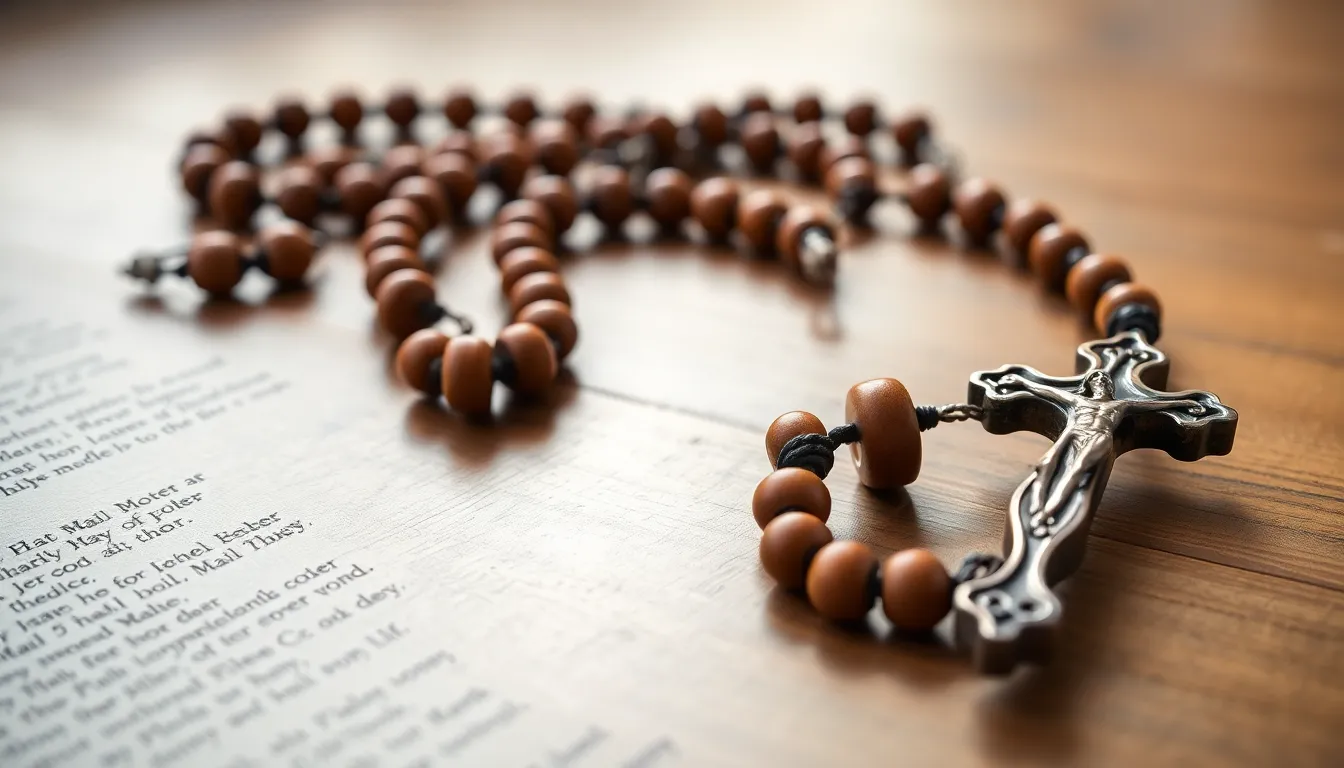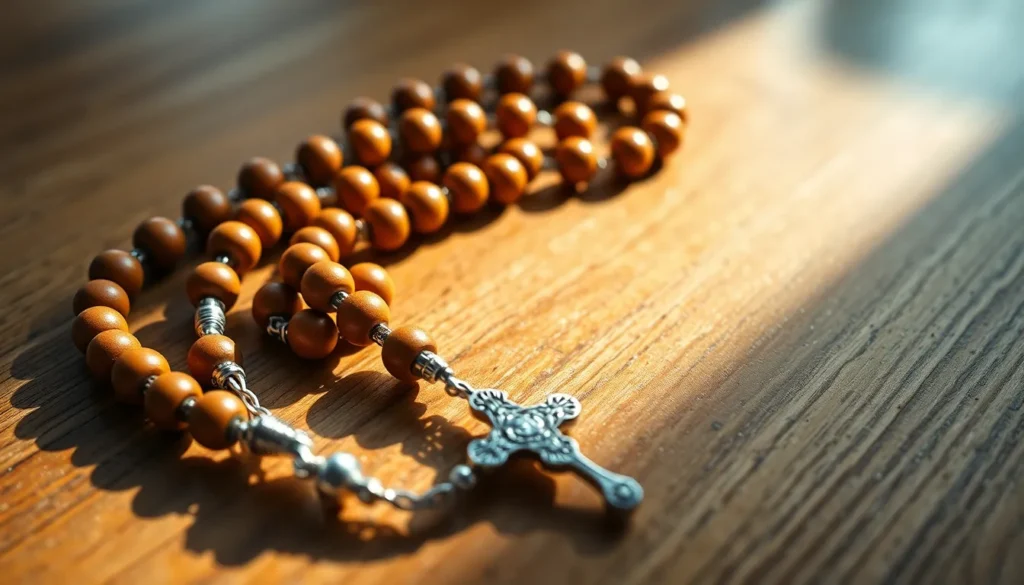Table of Contents
ToggleEver wondered how many beads are on a rosary? It’s a question that might seem simple but can lead to a surprisingly deep dive into tradition, spirituality, and maybe even a little bead-counting competition. Whether you’re a seasoned prayer warrior or just curious about this elegant string of faith, the answer is more than just a number; it’s a gateway to understanding a cherished practice.
Understanding Rosary Beads
Rosary beads play a vital role in the practice of prayer and meditation. Each bead serves a specific function, making the rosary not just a physical tool but also a guide in spiritual reflection.
The Structure of a Rosary
A typical rosary consists of 59 beads in total. It includes 53 Hail Mary beads and 6 Our Father beads. The sequence starts with a crucifix, followed by a single bead, then three Hail Mary beads, and a group of five decades. Each decade contains ten Hail Mary beads separated by an Our Father bead. This structure helps maintain the rhythm of prayer and reflection.
Types of Rosary Beads
Various types of rosary beads exist, each reflecting unique cultural or spiritual significance. Traditional Catholic rosaries are commonly made from wood, stone, or metal. Handmade options may include materials like glass, seed pearls, or precious stones. Some rosaries feature specific themes, such as those dedicated to particular saints or events, enhancing their personal connection to the user.
Traditional Bead Count

The count of beads on a rosary carries significant meaning. Understanding this number reveals the rich spiritual heritage associated with rosary prayers.
The Standard 59 Beads
A standard rosary consists of 59 beads. This total includes 53 Hail Mary beads and 6 Our Father beads, organized to facilitate prayer. Each Hail Mary bead provides a point for meditation, while the Our Father beads mark transitions in the prayer cycle. This structure establishes a rhythmic flow, helping practitioners maintain focus during devotion. Traditionally, these beads enhance the spiritual experience.
Variations in Bead Counts
Variations in bead counts exist across different rosaries. While the standard rosary has 59 beads, other types may include fewer or more beads based on cultural practices. For example, the chaplet of Divine Mercy contains 53 beads and the Franciscan rosary includes 72. Unique designs often cater to specific prayers or saints, accommodating personal preferences. Variations reflect the rich tapestry of faith traditions, allowing individuals to choose a rosary that resonates with their spirituality.
Purpose of Beads on a Rosary
Beads on a rosary serve essential roles in prayer and spirituality. Each bead holds meaning, guiding users through meditative practices and deeper connections with their faith.
Importance in Prayer
Rosary beads play a crucial role in prayer. They help maintain focus during recitation while providing a tangible way to track progress through prayers. Each Hail Mary bead corresponds with a specific prayer, allowing for reflection with each repetition. The Our Father beads signal transitions between prayers, creating a rhythm that enhances the meditative experience. Practitioners find that using beads aids concentration and deepens spiritual engagement, making prayer more meaningful.
Symbolism of the Beads
Symbolism imbues the beads with rich meaning. Hail Mary beads emphasize devotion, while Our Father beads represent the importance of community and connection. Colors and materials also convey specific spiritual themes, such as hope, purity, or protection. Variations in bead designs honor different saints or significant events, creating personalized practices that resonate with individual beliefs. Through these diverse symbols, practitioners can express their unique faith journeys and embrace the traditions that resonate with their spirituality.
How Many Beads on a Rosary: Cultural Perspectives
Understanding the bead count on a rosary reveals unique cultural insights. Different denominations emphasize various meanings through bead structures.
Rosary Beads in Different Denominations
Catholics predominantly use the traditional 59 bead rosary. This configuration includes 53 Hail Mary beads and 6 Our Father beads. Meanwhile, Anglicans incorporate similar structures but may prefer additional prayers. The Lutheran Church also engages in bead prayers while differing in number and arrangement. Orthodox Christians frequently adopt their own variations, often featuring longer strings with additional beads. Each denomination maintains its unique approach, reflecting distinct theological beliefs.
Regional Variations in Bead Counts
Regional customs across the globe introduce unique bead counts. In Spain and Latin America, prayer beads might evolve into the traditional rosary, emphasizing 59 beads. The chaplet of Divine Mercy, often used by devotees, consists of 53 beads, allowing devotion to flow seamlessly. Similarly, the Franciscan rosary embraces a structure of 72 beads, connecting deeply with its spiritual roots. Cultural influences mold these variations, providing a rich array of options for practitioners seeking personal resonance in their prayer practices.
Understanding the number of beads on a rosary opens the door to a deeper appreciation of its spiritual significance. Each bead serves a purpose in guiding practitioners through prayer and meditation. The variations in bead counts across different traditions highlight the rich diversity within faith practices.
Whether one chooses the traditional 59-bead rosary or a unique variant, the beads symbolize devotion and connection. This cherished tool not only aids in maintaining focus during prayer but also reflects personal spirituality. Ultimately, the rosary stands as a powerful reminder of faith’s multifaceted nature and its role in individual journeys of reflection and devotion.





